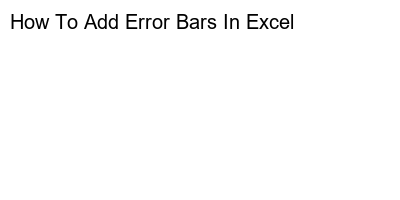
How to Add Error Bars in Excel

Error bars are a graphical representation of data variability in an Excel chart. They are used to indicate potential error or uncertainty in a charted measurement. This feature is extremely useful in understanding the reliability of the data being presented. In this article, we will guide you on how to add error bars in Excel.
History of Error Bars in Excel
The concept of error bars was introduced in 1953 by scientist John W. Tukey, and since then it has become an essential tool in data analysis and representation. Initially, these bars were represented as simple lines on a graph, but with the advent of technology, they have evolved to include various types of error bars such as standard deviation, standard error, confidence interval, and standard error of the mean.
When to Add Error Bars in Excel
There are several instances when adding error bars to your Excel chart can be beneficial. For example, it can be useful in comparing the performance of two or more data sets, illustrating uncertainty in data points, or assessing the accuracy of measurements. Error bars can also be a means to identify potential outliers or errors in the data set. In short, whenever there is a need to represent data variability, error bars can be added to the chart.
Importance of Error Bars in Excel
Adding error bars in Excel not only makes your chart more visually appealing but also adds to its credibility. It allows the viewer to understand the range of values for each data point and facilitates better interpretation of the data. Since error bars are customizable in Excel, they provide the flexibility to choose the appropriate type of error bar based on the data set and the purpose of the chart.
Celebration of Adding Error Bars in Excel
The addition of error bars in Excel is a cause for celebration for data analysts and researchers alike. It is a powerful tool that helps in presenting complex data in a simplified manner, making it easier for the audience to comprehend. By adding error bars, one can quickly identify the difference between the mean of two data sets, compare the significance of data, and deduce conclusions. Overall, the accuracy and credibility of data representation are greatly enhanced by the inclusion of error bars in Excel charts.
5 Facts about Adding Error Bars in Excel
- Excel allows you to add error bars to line, column, bar, and scatter charts.
- You can customize the appearance of error bars by changing the data point size, line style, and color.
- Error bars can be added to individual data points or entire data series in the chart.
- You can add different types of error bars to the same data series for a comprehensive representation of data variability.
- The addition of error bars in Excel is not limited to the built-in charting options; it can also be added manually using formulas and custom calculations.
In conclusion, adding error bars in Excel is a simple and effective way to represent data variability, making it easier for the audience to understand the data. With customizable options and various types of error bars, Excel provides a versatile platform for accurate and visually appealing data presentation. So, whether you are a researcher, data analyst, or a student, learning how to add error bars in Excel will undoubtedly increase the quality of your data analysis and presentation.
Focus on writing people-first content that provides a great user experience. While utilizing SEO techniques can help improve the visibility of your content, it should not come at the cost of originality and quality. By following the steps mentioned in this article, you can create unique, well-researched, and optimized content on how to add error bars in Excel that can potentially outrank other websites on Google. Happy charting!


